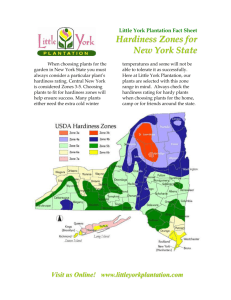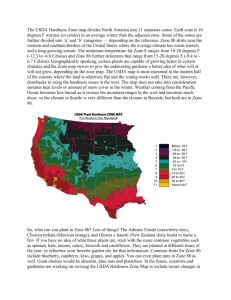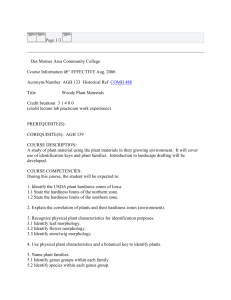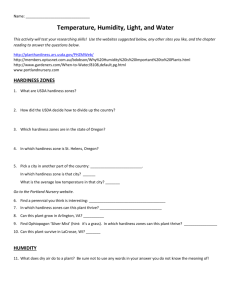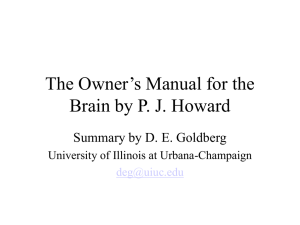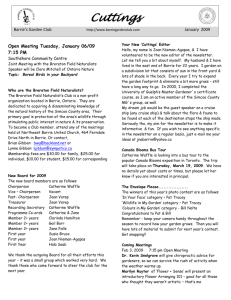Appendix_I - American Psychological Association
advertisement
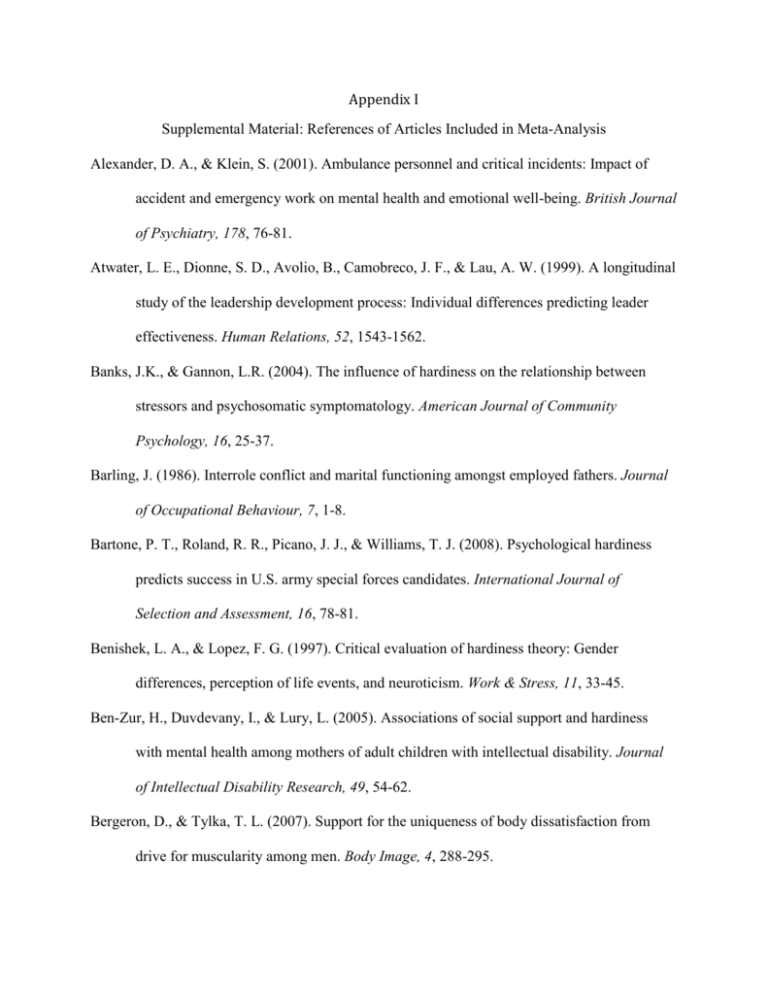
Appendix I Supplemental Material: References of Articles Included in Meta-Analysis Alexander, D. A., & Klein, S. (2001). Ambulance personnel and critical incidents: Impact of accident and emergency work on mental health and emotional well-being. British Journal of Psychiatry, 178, 76-81. Atwater, L. E., Dionne, S. D., Avolio, B., Camobreco, J. F., & Lau, A. W. (1999). A longitudinal study of the leadership development process: Individual differences predicting leader effectiveness. Human Relations, 52, 1543-1562. Banks, J.K., & Gannon, L.R. (2004). The influence of hardiness on the relationship between stressors and psychosomatic symptomatology. American Journal of Community Psychology, 16, 25-37. Barling, J. (1986). Interrole conflict and marital functioning amongst employed fathers. Journal of Occupational Behaviour, 7, 1-8. Bartone, P. T., Roland, R. R., Picano, J. J., & Williams, T. J. (2008). Psychological hardiness predicts success in U.S. army special forces candidates. International Journal of Selection and Assessment, 16, 78-81. Benishek, L. A., & Lopez, F. G. (1997). Critical evaluation of hardiness theory: Gender differences, perception of life events, and neuroticism. Work & Stress, 11, 33-45. Ben-Zur, H., Duvdevany, I., & Lury, L. (2005). Associations of social support and hardiness with mental health among mothers of adult children with intellectual disability. Journal of Intellectual Disability Research, 49, 54-62. Bergeron, D., & Tylka, T. L. (2007). Support for the uniqueness of body dissatisfaction from drive for muscularity among men. Body Image, 4, 288-295. Bernard, L. C., & Belinsky, D. (1993). Hardiness, stress, and maladjustment: Effects on selfreported retrospective health problems and prospective health center visits. Journal of Social Behavior & Personality, 8, 97-110. Bernas, K. H., & Major, D. A. (2000). Contributors to stress resistance: Testing a model of women's work–family conflict. Psychology of Women Quarterly, 24, 170-178. Berwick, K. R. (1992). Stress among student affairs administrators: The relationship of personal characteristics and organizational variables to work-related stress. Journal of College Student Development, 33, 11-19. Betz, N. E., Wohlgemuth, E., Serling, D., Harshbarger, J., & al, e. (1995). Evaluation of a measure of self-esteem based on the concept of unconditional self-regard. Journal of Counseling & Development, 74, 76-83. Blaney, N. T., Goodkin, K., Morgan, R. O., Feaster, D., & al, e. (1991). A stress-moderator model of distress in early HIV-1 infection: Concurrent analysis of life events, hardiness and social support. Journal of Psychosomatic Research, 35, 297-305. Britt, T. W., Adler, A. B., & Bartone, P. T. (2001). Deriving benefits from stressful events: The role of engagement in meaningful work and hardiness. Journal of Occupational Health Psychology, 6, 53-63. Brookings, J. B., & Bolton, B. (1997). A longitudinal, structural equation analysis of stress, hardiness, social support, depression, and illness. Multivariate Experimental Clinical Research, 11, 109-120. Brummett, B. R., Wade, J. C., Ponterotto, J. G., Thombs, B., & Lewis, C. (2007). Psychosocial well-being and a multicultural personality disposition. Journal of Counseling & Development, 85, 73-81. Campbell, J., Swank, P., & Vincent, K. R. (1991). The role of hardiness in the resolution of grief. Omega: Journal of Death and Dying, 23, 53-65. Chan, D. W. (2000). Dimensionality of hardiness and its role in the stress-distress relationship among Chinese adolescents in Hong Kong. Journal of Youth and Adolescence, 29, 147161. Chan, D. W. (2003). Hardiness and its role in the stress-burnout relationship among prospective Chinese teachers in Hong Kong. Teaching and Teacher Education, 19, 381-395. Clark, L. M., & Hartman, M. (1996). Effects of hardiness and appraisal on the psychological distress and physical health of caregivers to elderly relatives. Research on Aging, 18, 379-401. Clarke, D. E. (1995). Vulnerability to stress as a function of age, sex, locus of control, hardiness and type A personality. Social Behavior and Personality, 23, 285-286. Cole, M. S., Bruch, H., & Vogel, B. (2006). Emotion as mediators of the relations between perceived supervisor support and psychological hardiness on employee cynicism. Journal of Organizational Behavior, 27, 463-484. Compton, W. C., Seeman, J., & Norris, R. C. (1991). Predicting hardiness: A search for the parameters of deep cognitive structures. Medical Psychotherapy: An International Journal, 4, 121-129. Connor, K. M, & Davidson, J. R. T. (2003). Development of a new resilience scale: The ConnorDavidson Resilience Scale (CD-RISC). Depression and Anxiety, 18, 76-82. Contrada, R. J. (1989). Type A behavior, personality hardiness, and cardiovascular responses to stress. Journal of Personality and Social Psychology, 57, 895-903. Dillon, K. M., & Totten, M. C. (1989). Psychological factors, immunocompetence, and health of breast-feeding mothers and their infants. Journal of Genetic Psychology, 150, 155-162. Dolbier, C. L., Smith, S. E., & Steinhardt, M. A. (2007). Relationships of protective factors to stress and symptoms of illness. American Journal of Health Behavior, 31, 423-433. Dolbier, C. L., & Steinhardt, M. A. (2000). The development and validation of the sense of support scale. Behavioral Medicine, 25, 169-179. Duquette, A., Kerouac, S., Sandhu, B. K., Ducharme, F., & al, e. (1995). Psychosocial determinants of burnout in geriatric nursing. International Journal of Nursing Studies, 32, 443-456. Eid, J., Johnsen, B. H., Saus, E., & Risberg, J. (2004). Stress and coping in a week-long disabled submarine exercise. Aviation, Space, and Environmental Medicine, 75, 616-621. Eid, J., & Morgan, C. A. (2006). Dissociation, hardiness, and performance in military cadets participating in survival training. Military Medicine, 171, 436-442. Epstein, S., & Katz, L. (1992). Coping ability, stress, productive load, and symptoms. Journal of Personality and Social Psychology, 62, 813-825. Evans, D. R., Pellizzari, J. R., Culbert, B. J., & Metzen, M. E. (1993). Personality, marital, and occupational factors associated with quality of life. Journal of Clinical Psychology, 49, 477-485. Farber, E. W., Schwartz, J. A. J., Schaper, P. E., Moonen, D. J., & McDaniel, J. S. (2000). Resilience factors associated with adaptation to HIV disease. Psychosomatics: Journal of Consultation Liaison Psychiatry, 41, 140-146. Feinauer, L., Hilton, H. G., & Callahan, E. H. (2003). Hardiness as a moderator of shame associated with childhood sexual abuse. American Journal of Family Therapy, 31, 65-78. Florian, V., Mikulincer, M., & Hirschberger, G. (2001). An existentialist view on mortality salience effects: Personal hardiness, death-thought accessibility, and cultural worldview defence. British Journal of Social Psychology, 40, 437-453. Florian, V., Mikulincer, M., & Taubman, O. (1995). Does hardiness contribute to mental health during a stressful real-life situation? The roles of appraisal and coping. Journal of Personality and Social Psychology, 68, 687-695. Foster, M. D., & Dion, K. L. (2003). Dispositional hardiness and women's well-being relating to gender discrimination: The role of minimization. Psychology of Women Quarterly, 27, 197-208. Foster, M. D., & Dion, K. L. (2004). The role of hardiness in moderating the relationship between Global/Specific attributions and actions against discrimination. Sex Roles, 51, 161-169. Fowler, K. L. (2006). The relations between personality characteristics, work environment, and the professional well-being of music therapists. Journal of Music Therapy, 43, 174-197. Fullerton, C. S., Ursano, R. J., Kao, T., & Bharitya, V. R. (1999). Disaster-related bereavement: Acute symptoms and subsequent depression. Aviation, Space, and Environmental Medicine, 70, 902-909. Funk, S. C., & Houston, B. K. (1987). A critical analysis of the hardiness scale's validity and utility. Journal of Personality and Social Psychology, 53, 572-578. Fusilier, M., & Manning, M. R. (2005). Psychosocial predictors of health status revisited. Journal of Behavioral Medicine, 28, 347-358. Ganellen, R. J., & Blaney, P. H. (1984). Hardiness and social support as moderators of the effects of life stress. Journal of Personality and Social Psychology, 47, 156-163. Ghorbani, N., Watson, P. J., & Morris, R. J. (2000). Personality, stress and mental health: Evidence of relationships in a sample of Iranian managers. Personality and Individual Differences, 28, 647-657. Ghorbani, N., & Watson, P. J. (2005). Hardiness scales in Iranian managers: Evidence of incremental validity in relationships with the five factor model and with organizational and psychological adjustment. Psychological Reports, 96, 775-781. Gill, M. J., & Harris, S. L. (1994). Hardiness and social support as predictors of psychological discomfort in mothers of children with autism. Journal of Autism and Developmental Disorders, 21, 407-416. Golby, J., & Sheard, M. (2004). Mental toughness and hardiness at different levels of rugby league. Personality and Individual Differences, 37, 933-942. Goss, J. D. (1994). Hardiness and mood disturbances in swimmers while overtraining. Journal of Sport & Exercise Psychology, 16, 135-149. Gramzow, R. H., Sedikides, C., Panter, A. T., & Insko, C. A. (2000). Aspects of self-regulation and self-structure as predictors of perceived emotional distress. Personality and Social Psychology Bulletin, 26, 188-205. Hamama-Raz, Y., & Solomon, Z. (2006). Psychological adjustment of melanoma survivors: The contribution of hardiness, attachment, and cognitive appraisal. Journal of Individual Differences, 27, 172-182. Hannah, T. E. (1988). Hardiness and health behavior: The role of health concern as a moderator variable. Behavioral Medicine, 14, 59-63. Harris, S. M. (2004). The effect of health value and ethnicity on the relationship between hardiness and health behaviors. Journal of Personality, 72, 379-411. Heckman, C. J., & Clay, D. L. (2005). Hardiness, history of abuse and women's health. Journal of Health Psychology, 10, 767-777. Hobfoll, S. E. (1989). Conservation of resources: A new attempt at conceptualizing stress. American Psychologist, 44, 513–524. Horner, K. L. (1998). Individuality in vulnerability: Influences on physical health. Journal of Health Psychology, 3, 71-85. Hull, J. G., Van Treuren, R. R., & Virnelli, S. (1987). Hardiness and health: A critique and alternative approach. Journal of Personality and Social Psychology, 53, 518-530. Jantzer, A. M., Hoover, J. H., & Narloch, R. (2006). The relationship between school-aged bullying and trust, shyness and quality of friendships in young adulthood: A preliminary research note. School Psychology International, 27, 146-156. Judkins, S., & Rind, R. (2005). Hardiness, job satisfaction, and stress among home health nurses. Home Health Care Management & Practice, 17, 113-118. Kashubeck, S. (1994). Adult children of alcoholics and psychological distress. Journal of Counseling & Development, 72, 538-543. Kashubeck, S., & Christensen, S. A. (1992). Differences in distress among adult children of alcoholics. Journal of Counseling Psychology, 39, 356-362. Kelley, B. C., Eklund, R. C., & Ritter-Taylor, M. (1999). Stress and burnout among collegiate tennis coaches. Journal of Sport & Exercise Psychology, 21, 113-130. Klag, S., & Bradley, G. (2004). The role of hardiness in stress and illness: An exploration of the effect of negative affectivity and gender. British Journal of Health Psychology, 9, 137161. Klibert, J. J., Langhinrichsen-Rohling, J., & Saito, M. (2005). Adaptive and maladaptive aspects of self-oriented versus socially prescribed perfectionism. Journal of College Student Development, 46, 141-156. Kobasa, S. C., Maddi, S. R., & Courington, S. (1981). Personality and constitution as mediators in the stress - illness relationship. Journal of Health and Social Behavior, 22, 368-378. Kobasa, S. C., Maddi, S. R., & Kahn, S. (1982). Hardiness and health: A prospective study. Journal of Personality and Social Psychology, 42, 168-177. Kobasa, S. C., Maddi, S. R., & Zola, M. A. (1983). Type A and hardiness. Journal of Behavioral Medicine, 6, 41-51. Kobasa, S. C., & Puccetti, M. C. (1983). Personality and social resources in stress resistance. Journal of Personality and Social Psychology, 45, 839-850. Korotkov, D., & Hannah, E. (1994). Extraversion and emotionality as proposed superordinate stress moderators: A prospective analysis. Personality and Individual Differences, 16, 787-792. Kravetz, S., Drory, Y., & Florian, V. (1993). Hardiness and sense of coherence and their relation to negative affect. European Journal of Personality, 7, 233-244. Lambert, V. A., Lambert, C. E., Petrini, M., Li, X. M., & Zhang, Y. J. (2007). Workplace and personal factors associated with physical and mental health in hospital nurses in china. Nursing & Health Sciences, 9, 120-126. Lang, A., Goulet, C., & Amsel, R. (2003). Lang and Goulet hardiness scale: Development and testing on bereaved parents following the death of their fetus/infant. Death Studies, 27, 851-880. Langemo, D. K. (1990). Impact of work stress on female nurse educators. IMAGE: Journal of Nursing Scholarship, 22, 159-162. Leak, G. K., & Williams, D. E. (1989). Relationship between social interest, alienation, and psychological hardiness. Individual Psychology: Journal of Adlerian Theory, Research & Practice, 45, 369-375. Lee, H. J. (1991). Relationship of hardiness and current life events to perceived health in rural adults. Research in Nursing & Health, 14, 351-359. Lerner, Y., Kertes, J., & Zilber, N. (2005). Immigrants from the former soviet union, 5 years post-immigration to Israel: Adaptation and risk factors for psychological distress. Psychological Medicine: A Journal of Research in Psychiatry and the Allied Sciences, 35, 1805-1814. Lindberg, M. A. (2002). The role of suggestions and personality characteristics in producing illness reports and desires for suing the responsible party. Journal of Psychology: Interdisciplinary and Applied, 136, 125-140. Lopez, O., Haigh, C., & Burney, S. (2004). Relationship between hardiness and perceived stress in two generations of Latin American migrants. Australian Psychologist, 39, 238-243. Luszczynska, A., & Cieslak, R. (2005). Protective, promotive, and buffering effects of perceived social support in managerial stress: The moderating role of personality. Anxiety, Stress & Coping: An International Journal, 18, 227-244. MacEwen, K. E., & Barling, J. (1988). Interrole conflict, family support and marital adjustment of employed mothers: A short term, longitudinal study. Journal of Organizational Behavior, 9, 241-250. Maddi, S. R. (1999). The personality construct of hardiness: I. effects on experiencing, coping, and strain. Consulting Psychology Journal: Practice and Research, 51, 83-94. Maddi, S. R., Brow, M., Khoshaba, D. M., & Vaitkus, M. (2006). Relationship of hardiness and religiousness to depression and anger. Consulting Psychology Journal: Practice and Research, 58, 148-161. Maddi, S. R., Harvey, R. H., Khoshaba, D. M., Lu, J. L., Persico, M., & Brow, M. (2006). The personality construct of hardiness, III: Relationships with repression, innovativeness, authoritarianism, and performance. Journal of Personality, 74, 575-598. Maddi, S. R., & Hightower, M. (1999). Hardiness and optimism as expressed in coping patterns. Consulting Psychology Journal: Practice and Research, 51, 95-105. Maddi, S. R., Khoshaba, D. M., Persico, M., Lu, J., Harvey, R., & Bleecker, F. (2002). The personality construct of hardiness: II. relationships with comprehensive test of personality and psychopathology. Journal of Research in Personality, 36, 72-85. Maddi, S. R., Wadhwa, P., & Haier, R. J. (1996). Relationship of hardiness to alcohol and drug use in adolescents. The American Journal of Drug and Alcohol Abuse, 22, 247-257. Magnani, L. E. (1990). Hardiness, self-perceived health, and activity among independently functioning older adults. Scholarly Inquiry for Nursing Practice, 4, 171-184. Martin, J. J., Kelley, B., & Eklund, R. C. (1999). A model of stress and burnout in male high school athletic directors. Journal of Sport & Exercise Psychology, 21, 280-294. Mathews, L. L., & Servaty-Seib, H. (2007). Hardiness and grief in a sample of bereaved college students. Death Studies, 31, 183-204. Mathis, M., & Lecci, L. (1999). Hardiness and college adjustment: Identifying students in need of services. Journal of College Student Development, 40, 305-309. May, K. M., Sowa, C. J., & Niles, S. G. (1993). Family environments as predictors of personality hardiness and self-efficacy. The Family Journal, 1, 131-135. Mayseless, O. (2004). Home leaving to military service: Attachment concerns, transfer of attachment functions from parents to peers, and adjustment. Journal of Adolescent Research, 19, 533-558. McCalister, K. T., Dolbier, C. L., Webster, J. A., Mallon, M. W., & Steinhardt, M. A. (2006). Hardiness and support at work as predictors of work stress and job satisfaction. American Journal of Health Promotion, 20, 183-191. McCranie, E. W., Lambert, V. A., & Lambert, C. E. (1987). Work stress, hardiness, and burnout among hospital staff nurses. Nursing Research, 36, 374-378. McNeil, K., Kozma, A., Stones, M. J., & Hannah, E. (1986). Measurement of psychological hardiness in older adults. Canadian Journal on Aging, 5, 43-48. Michielsen, H. J., Croon, M. A., Willemsen, T. M., De Vries, J., & Van Heck, G. L. (2007). Which constructs can predict emotional exhaustion in a working population? A study into its determinants. Stress and Health: Journal of the International Society for the Investigation of Stress, 23, 121-130. Michielsen, H. J., De Vries, J., & Van Heck, G. L. (2003). In search of personality and temperament predictors of chronic fatigue: A prospective study. Personality and Individual Differences, 35, 1073-1087. Morrissey, C., & Hannah, T. E. (1987). Measurement of psychological hardiness in adolescents. Journal of Genetic Psychology, 148, 393-395. Nagy, S., & Nix, C. L. (1989). Relations between preventive health behavior and hardiness. Psychological Reports, 65, 339-345. Neria, Y., Guttmann-Steinmetz, S., Koenen, K., Levinovsky, L., Zakin, G., & Dekel, R. (2001). Do attachment and hardiness relate to each other and to mental health in real-life stress. Journal of Social and Personal Relationships, 18, 844-858. Nicholls, A. R., Polman, R. C. J., Levy, A. R., Backhouse, S. H. (2008). Mental toughness, optimism, pessimism, and coping among athletes. Personality and Individual Differences, 44, 1182-1192. Nowack, K. M. (1986). Type A, hardiness, and psychological distress. Journal of Behavioral Medicine, 9, 537-548. Nowack, K. M. (1989). Coping style, cognitive hardiness, and health status. Journal of Behavioral Medicine, 12, 145-158. Nowack, K. M. (1990). Initial development of an inventory to assess stress and health risk. American Journal of Health Promotion, 4, 173-180. Nowack, K. M. (1991). Psychosocial predictors of health status. Work & Stress, 5, 117-131. Nowack, K. M., & Hanson, A. L. (1983). The relationship between stress, job performance, and burnout in college student resident assistants. Journal of College Student Personnel, 24, 545-550. Okun, M. A., Zautra, A. J., & Robinson, S. E. (1988). Hardiness and health among women with rheumatoid arthritis. Personality and Individual Differences, 9, 101-107. Orme, J. G., Cuddeback, G. S., Buehler, C., Cox, M. E., & Le Prohn, N. S. (2007). Measuring foster parent potential: Casey foster parent inventory-applicant version. Research on Social Work Practice, 17, 77-92. Otero Lopez, J. M., Santiago, M. J., Godas, A., Castro, C., Villardefrancos, E., & Ponte, D. (2008). An integrative approach to burnout in secondary school teachers: Examining the role of student disruptive behaviour and disciplinary issues. International Journal of Psychology and Psychological Therapy, 8, 259-270. Paulik, K. (2001). Hardiness, optimism, self-confidence and occupational stress among university teachers. Studia Psychologica, 43, 91-100. Pengilly, J. W., & Dowd, E. T. (2000). Hardiness and social support as moderators of stress. Journal of Clinical Psychology, 56, 813-820. Priel, B., Gonik, N., & Rabinowitz, B. (1993). Appraisals of childbirth experience and newborn characteristics: The role of hardiness and affect. Journal of Personality, 61, 299-315. Rhodewalt, F., & Agustsdottir, S. (1984). On the relationship of hardiness to the type A behavior pattern: Perception of life events versus coping with life events. Journal of Research in Personality, 18, 211-223. Rhodewalt, F., & Zone, J. B. (1989). Appraisal of life change, depression, and illness in hardy and nonhardy women. Journal of Personality and Social Psychology, 56, 81-88. Rich, V. L., & Rich, A. R. (1987). Personality hardiness and burnout in female staff nurses. IMAGE: Journal of Nursing Scholarship, 19, 63-66. Robitschek, C., & Kashubeck, S. (1999). A structural model of parental alcoholism, family functioning, and psychological health: The mediating effects of hardiness and personal growth orientation. Journal of Counseling Psychology, 46, 159-172. Rosen, L. N., Wright, K., Marlowe, D., Bartone, P., & Gifford, R. K. (1999). Gender differences in subjective distress attributable to anticipation of combat among U.S. army soldiers deployed to the Persian Gulf during operation desert storm. Military Medicine, 164, 753757. Roth, D. L., Wiebe, D. J., Fillingim, R. B., & Shay, K. A. (1989). Life events, fitness, hardiness, and health: A simultaneous analysis of proposed stress-resistance effects. Journal of Personality and Social Psychology, 57, 136-142. Rowe, M. M. (2006). Four-year longitudinal study of behavioral changes in coping with stress. American Journal of Health Behavior, 30, 602-612. Rush, M. C., Schoel, W. A., & Barnard, S. M. (1995). Psychological resiliency in the public sector: "hardiness" and pressure for change. Journal of Vocational Behavior, 46, 17-39. Samson, J. A., Mirin, S. M., Hauser, S. T., Fenton, B. T., & al, e. (1992). Learned helplessness and urinary MHPG levels in unipolar depression. The American Journal of Psychiatry, 149, 806-809. Schafer, W. E., & McKenna, J. F. (1991). Perceived energy and stress resistance: A study of city managers. Journal of Social Behavior & Personality, 6, 271-282. Schmied, L. A., & Lawler, K. A. (1986). Hardiness, type A behavior, and the stress - illness relation in working women. Journal of Personality and Social Psychology, 51, 12181223. Sharpley, C. F., & Yardley, P. (1999). The relationship between cognitive hardiness, explanatory style, and depression-happiness in postretirement men and women. Australian Psychologist, 34, 198-203. Sheard, M., & Golby, J. (2007). Hardiness and undergraduate academic study: The moderating role of commitment. Personality and Individual Differences, 43, 579-588. Sheppard, J. A., & Kashani, J. H. (1991). The relationship of hardiness, gender, and stress to health outcomes in adolescents. Journal of Personality, 59, 747-768. Sinclair, R. R., & Tetrick, L. E. (2000). Implications of item wording for hardiness structure, relation with neuroticism, and stress buffering. Journal of Research in Personality, 34, 125. Smith, T. W., & Frohm, K. D. (1985). What's so unhealthy about hostility? Construct validity and psychosocial correlates of the cook and medley ho scale. Health Psychology, 4, 503520. Soderstrom, M., Dolbier, C., Leiferman, J., & Steinhardt, M. (2000). The relationship of hardiness, coping strategies, and perceived stress to symptoms of illness. Journal of Behavioral Medicine, 23, 311-328. Steinhardt, M. A., Dolbier, C. L., Gottlieb, N. H., & McCalister, K. T. (2003). The relationship between hardiness, supervisor support, group cohesion, and job stress as predictors of job satisfaction. American Journal of Health Promotion, 17, 382-389. Sutker, P. B., Davis, J. M., Uddo, M., & Ditta, S. R. (1995). War zone stress, personal resources, and PTSD in Persian Gulf War returnees. Journal of Abnormal Psychology, 104, 444452. Sweetman, M. E., Munz, D. C., & Wheeler, R. J. (1993). Optimism hardiness, and explanatory style as predictors of general well-being among attorneys. Social Indicators Research, 29, 153-161. Taft, C. T., Stern, A. S., King, L. A., & King, D. W. (1999). Modeling physical health and functional health status: The role of combat exposure, posttraumatic stress disorder and personal resource attributes. Journal of Traumatic Stress, 12, 3-23. Tang, T. L., & Hammontree, M. L. (1992). The effects of hardiness, police stress, and life stress on police officers' illness and absenteeism. Public Personnel Management, 21, 493-510. Thomson, W. C., & Wendt, J. C. (1995). Contribution of hardiness and school climate to alienation experienced by student teachers. Journal of Educational Research, 88, 269274. Topf, M. (1989). Personality hardiness, occupational stress, and burnout in critical care nurses. Research in Nursing & Health, 12, 179-186. Topf, M. (1989). Sensitivity to noise, personality hardiness, and noise-induced stress in critical care nurses. Environment and Behavior, 21, 717-733. Turnipseed, D. L. (1999). An exploratory study of the hardy personality at work and in health care industry. Psychological Reports, 85, 1199-1217 Turnipseed, D. L. (2003). Hardy personality: A potential link with organizational citizenship behavior. Psychological Reports, 93, 529-543. Vogt, D. S., Rizvi, S. L., Shipherd, J. C., & Resick, P. A. (2008). Longitudinal investigation of reciprocal relationship between stress reactions and hardiness. Personality and Social Psychology Bulletin, 34, 61-73. Wallace, K. A., Bisconti, T. L., & Bergeman, C. S. (2001). The meditational effect of hardiness on social support and optimal outcomes. Basic and Applied Social Psychology, 23, 267276. Waysman, M., Schwarzwald, J., & Solomon, Z. (2001). Hardiness: An examination of its relationship with positive and negative long term changes following trauma. Journal of Traumatic Stress, 14, 531-548. Weiss, K., Suedfeld, P., Steel, G. D., & Tanaka, M. (2000). Psychological adjustment during three japanese antarctic research expeditions. Environment and Behavior, 32, 142-156. Weiss, M. J. (2002). Hardiness and social support as predictors of stress in mothers of typical children, children with autism, and children with mental retardation. Autism, 6, 115-130. Wiebe, D. J. (1991). Hardiness and stress moderation: A test of proposed mechanisms. Journal of Personality and Social Psychology, 60, 89-99. Wiebe, D. J., & McCallum, D. M. (1986). Health practices and hardiness as mediators in the stress-illness relationship. Health Psychology, 5, 425-438. Williams, D., & Lawler, K. A. (2001). Stress and illness in low-income women: The roles of hardiness, John Henryism, and race. Women & Health, 32, 61-75. Williams, P. G., Wiebe, D. J., & Smith, T. W. (1992). Coping processes as mediators of the relationship between hardiness and health. Journal of Behavioral Medicine, 15, 237-255. Williams, S. J. (1990). The relationship among stress, hardiness, sense of coherence, and illness in critical care nurses. Medical Psychotherapy: An International Journal, 3, 171-186. Wohlfarth, T., Winkel, F. W., Ybema, J. F., & van, d. B. (2001). The relationship between socioeconomic inequality and criminal victimisation: A prospective study. Social Psychiatry and Psychiatric Epidemiology, 36, 361-370. Woodard, C. R. (2004). Hardiness and the concept of courage. Consulting Psychology Journal: Practice and Research, 56, 173-185. Yoon, H. (1997). Factors affecting quality of life of the korean aged stroke patients. The International Journal of Aging & Human Development, 44, 167-181. Younkin, S. L., & Betz, N. E. (1996). Psychological hardiness: A reconceptualization and measurement. Theory and assessment of stressful life events. (pp. 161-178) International Universities Press, Inc, Madison, CT. Zach, S., Raviv, S., & Inbar, R. (2007). The benefits of a graduated training program for security officers on physical performance in stressful situations. International Journal of Stress Management, 14, 350-369. Zakin, G., Solomon, Z., & Neria, Y. (2003). Hardiness, attachment style, and long term psychological distress among Israeli POWs and combat veterans. Personality and Individual Differences, 34, 819-829. Zorrilla, E. P., DeRubeis, R. J., & Redei, E. (1995). High self-esteem, hardiness and affective stability are associated with higher basal pituitary-adrenal hormone levels. Psychoneuroendocrinology, 20, 591-601.
